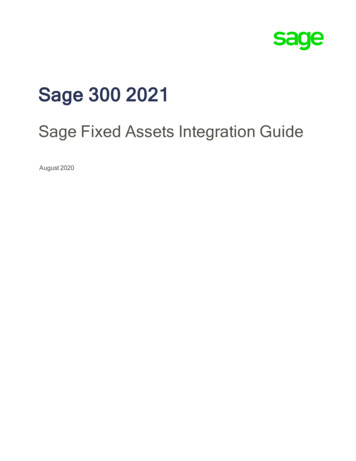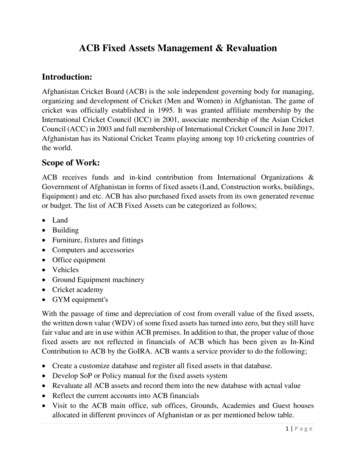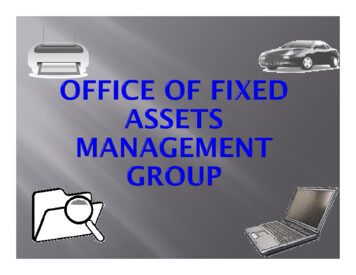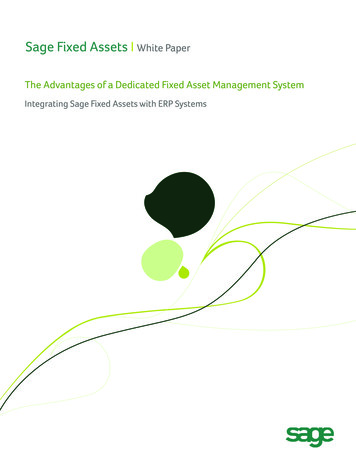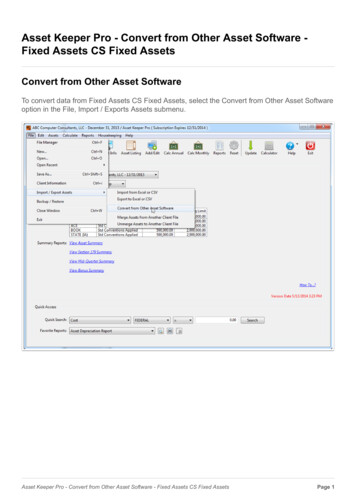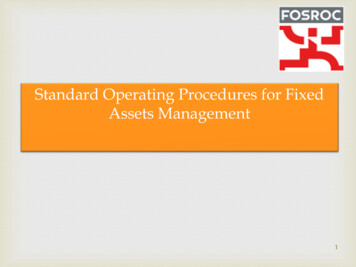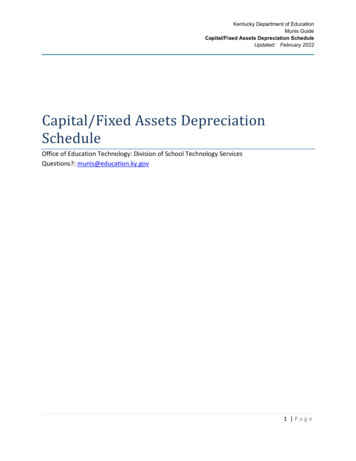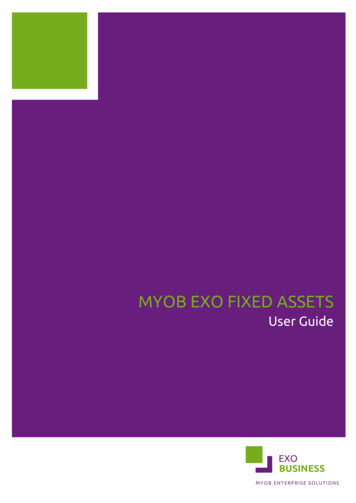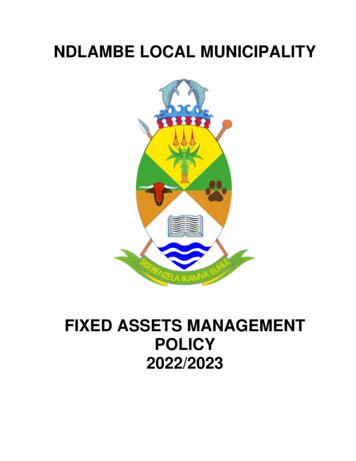
Transcription
NDLAMBE LOCAL MUNICIPALITYFIXED ASSETS MANAGEMENTPOLICY2022/2023
Table of contentsPagePart 1Definition of a Fixed Asset4Part 2Role of Municipal Manager4Part 3Role of Chief Financial Officer4Part 4Format of Fixed Asset Register4-5Part 5Classification of Fixed Assets5Part 6Investment Property6Part 7Fixed Assets Treated as Inventory6Part 8Recognition of Heritage Assets in theFixed Asset Register6Part 9Recognition of Donated Assets6Part 10Safekeeping of Assets and Internal Control7Part 11Identification of Fixed Assets7Part 12Procedure in Case of Loss, Theft, Destruction,or Impairment of Fixed Assets7Part 13Capitalization Criteria: Material Value7Part 14Capitalization Criteria: Intangible Items7Part 15Capitalization Criteria: Reinstatement,Maintenance and other Expenses8Part 16Maintenance Plans8Part 17Deferred Maintenance8Part 18General Maintenance of Fixed Assets8Part 19Depreciation of Fixed Assets8-9Part 20Rate of Depreciation9Part 21Method of Depreciation92
Part 22Amendment of Asset Lives & DiminutionIn the Value of Fixed Assets9 - 10Alternative Methods of DepreciationIn specific Instances10Part 24Carrying Values of Fixed Assets10Part 25Revaluation of Fixed Assets10Part 26Verification of Fixed Assets11Part 27Alienation of Fixed Assets11Part 28Other Write-offs of Fixed Assets12Part 29Replacement Norms12Part 30Insurance of Fixed Assets13Part 31Biological Assets13Part 32Annexure: Fixed Asset Lives13 - 17Part 33Annexure: Paraphrase of Section 14 of theMunicipal Finance Management Act 200317Part 233
PART 1: DEFINITION OF A FIXED ASSETA fixed asset is defined in GRAP 17 as a tangible item of property, plant or equipmentheld by a municipality for use in the productions or supply of goods or services, forrental to others, or for administrative purposes, and which is expected to be usedduring more than one reporting period (financial year).A fixed asset is thus an asset, either movable or immovable, under the control of themunicipality, and from which the municipality reasonably expects to derive economicbenefits, or reasonably expects to use in service delivery, over a period extendingbeyond one financial year.To be recognized as a fixed asset, an asset must also meet the criteria referred to inParts 13, 14 and 15 below.An asset held under a finance lease, shall be recognized as a fixed asset, as themunicipality has control over such an asset even though it does not own the asset.PART 2: ROLE OF MUNICIPAL MANAGERAs accounting officer of the municipality, the municipal manager shall be the principalcustodian of all the municipality’s fixed assets, and shall be responsible for ensuringthat the fixed asset management policy is scrupulously applied and adhered to.PART 3: ROLE OF CHIEF FINANCIAL OFFICERThe chief financial officer shall be the fixed asset registrar of the municipality, andshall ensure that a complete, accurate and up-to-date computerised fixed assetregister is maintained.No amendments, deletions or additions to the fixed asset register shall be made otherthan by the chief financial officer or by an official acting under the written instruction ofthe chief financial officer.PART 4: FORMAT OF FIXED ASSET REGISTERThe fixed asset register shall be maintained in the format determined by the chieffinancial officer, which format shall comply with the requirements of generallyrecognized accounting practice (GRAP) and any other accounting requirementswhich may be prescribed.The fixed asset register shall reflect the following information:4
a brief but meaningful description of each asset;the date on which the asset was acquired or brought into use;the location of the asset;the department(s)or vote(s)within which the assets will be used;the title deed number, in the case of fixed property;the stand number, in the case of fixed property;where applicable, the identification number, as determined in compliance withpart 11 below;the original cost, or the revalued amount determined in compliance with part 26below, or the fair value if no costs are available;the (last)revaluation date of the fixed assets subject to revaluation;the revalued value of such fixed assets;who did the (last)revaluation;accumulated depreciation to date;the depreciation charge for the current financial year;the carrying value of the asset;the method and rate of depreciation;impairment losses incurred during the financial year (and the reversal of suchlosses, where applicable);the source of financing;the current insurance arrangements;whether the asset is required to perform basic municipal services;whether the asset has been used to secure any debt, and – if so – the natureand duration of such security arrangements;the date on which the asset is disposed of;the disposal price;the date on which the asset is retired from use, if not disposed of.All heads of department under whose control any fixed asset falls shall promptlyprovide the chief financial officer in writing with any information required to compilethe fixed asset register, and shall promptly advise the chief financial officer in writingof any material change which may occur in respect of such information.A fixed asset shall be capitalized, that is, recorded in the fixed assets register, assoon as it is acquired. If the asset is constructed over a period of time, it shall berecorded as work-in-progress until it is available for use; thereafter it shall beappropriately capitalized as a fixed asset.5
A fixed asset shall remain in the fixed assets register for as long as it is in physicalexistence. The fact that a fixed asset has been fully depreciated shall not in itself be areason for writing-off such an asset.PART 5: CLASSIFICATION OF FIXED ASSETSIn compliance with the requirements of the National Treasury, the chief financialofficer shall ensure that all fixed assets are classified under the following headings inthe fixed assets register, and heads of departments shall in writing provide the chieffinancial officer with such information or assistance as is required to compile a properclassification:PROPERTY, PLANT AND EQUIPMENT land (not held as investment assets)infrastructure assets (assets which are part of a network of similar assets)community assets (resources contributing to the general well-being of thecommunity)heritage assets (culturally significant resources)other assets (ordinary operational resources)INVENTORY Assets held for sale in the ordinary course of business,In the process of production for such sale orIn the form of materials or supplies to be consumed in the production process.In the form of materials or supplies to be consumed or distributed in therendering of services.INVESTMENT PROPERTY Investment assets (resources held for capital or operational gain)The chief financial officer shall adhere to the classifications indicated in the annexureon fixed asset lives (see part 33 below), and in the case of a fixed asset notappearing in the annexure shall use the classification applicable to the asset mostclosely comparable to the asset in question.PART 6: INVESTMENT PROPERTYInvestment property is property (land or a building - or part of a building - or both) heldto earn rentals or for capital appreciation or both, rather than for:6
use in the production or supply of goods or services or foradministrative purposes, orsale in the ordinary course of operations.Owner-occupied property is property held for use in the production or supply of goodsor services or for administrative purposes.Investment property is recognised as an asset when, it is probable that the futureeconomic benefits or service potential that are associated with the investmentproperty will flow to the municipality, and the cost or fair value of the investmentproperty can be measured reliably.Investment property is initially recognised at cost. Transaction costs are included inthe initial measurement.Where investment property is acquired through a non-exchange transaction, its costis its fair value as at the date of acquisition.Costs include costs incurred initially and costs incurred subsequently to add to, or toreplace a part of, or service a property.If a replacement part is recognised in the carrying amount of the investment property,the carrying amount of the replaced part is derecognised.Investment property is carried at cost less accumulated depreciation less anyaccumulated impairment losses.Depreciation is provided to write down the cost, less estimated residual value byequal installments over the useful life of the propertyInvestment property is derecognised on disposal or when the investment property ispermanently withdrawn from use and no future economic benefits or service potentialare expected from its disposal.Gains or losses arising from the retirement or disposal of investment property is thedifference between the net disposal proceeds and the carrying amount of the assetand is recognised in surplus or deficit in the period of retirement or disposal.Compensation from third parties for investment property that was impaired, lost orgiven up is recognised in surplus or deficit when the compensation becomesreceivable.7
Investment assets shall be accounted for in terms of IAS 40 and shall not beclassified as property, plant and equipment for purposes of preparing themunicipality’s statement of position.Investment assets shall be recorded in the fixed assets register in the same manneras other fixed assets, but a separate section of the fixed assets register shall bemaintained for this purpose.If the Council of the municipality resolves to construct or develop a property for futureuse as an investment property, such property shall in every respect be accounted foras an ordinary fixed asset until it is ready for its intended use – hereafter it shall bereclassified as an investment asset.PART 7: INVENTORYInventories are assets:(a)(b)(c)(d)in the form of materials or supplies to be consumed in the production process;in the form of materials or supplies to be consumed or distributed in therendering of services;held for sale or distribution in the ordinary course of operations; orin the process of production for sale or distribution.Inventories are initially measured at cost except where there are inventory exchangetransactions, then their costs are their fair value as at the date of acquisition.Subsequently inventories are measured at the lower of cost and net realisable value.Inventories are measured at the lower of cost and current replacement cost wherethey are held for; distribution at no charge or for a nominal charge; orconsumption in the production process of goods to be distributed at nocharge or for a nominal charge.Net realisable value is the estimated selling price in the ordinary course of operationsless the estimated costs of completion and the estimated costs necessary to makethe sale, exchange or distribution.Current replacement cost is the cost the municipality incurs to acquire the asset onthe reporting date.8
The cost of inventories comprises of all costs of purchase, costs of conversion andother costs incurred in bringing the inventories to their present location and condition.The cost of inventories of items that are not ordinarily interchangeable and goods orservices produced and segregated for specific projects is assigned using specificidentification of the individual costs.The cost of inventories is assigned using the weighted average cost formula. Thesame cost formula is used for all inventories having a similar nature and use to themunicipality.When inventories are sold, the carrying amounts of those inventories are recognisedas an expense in the period in which the related revenue is recognised. If there is norelated revenue, the expenses are recognised when the goods are distributed, orrelated services are rendered. The amount of any write-down of inventories to netrealisable value or current replacement cost and all losses of inventories arerecognised as an expense in the period the write-down or loss occurs.The amount of any reversal of any write-down of inventories, arising from an increasein net realisable value or current state, are recognized as a reduction in the amount ofinventories recognised as an expense in the period in which the reversal occurs.PART 8: RECOGNITION OF HERITAGE ASSETS IN THE FIXED ASSETREGISTERIf no original costs or fair values are available in the case of one or more or allheritage assets, the chief financial officer may, if it is believed that the determinationof a fair value for the assets in question will be a laborious or expensive undertaking,record such asset or assets in the fixed asset register without an indication of thecosts or fair value concerned.For balance sheet purposes, the existence of such heritage assets shall be disclosedby means of an appropriate note.PART 9: RECOGNITION OF DONATED ASSETSWhere a fixed asset is donated to the municipality, or a fixed asset is acquired bymeans of an exchange of assets between the municipality and one or more otherparties, the asset concerned shall be recorded in the fixed asset register at its fairvalue, as determined by the chief financial officer.9
PART 10: SAFEKEEPING OF ASSETS AND INTERNAL CONTROLEvery head of department shall be directly responsible for the physical safekeeping ofany fixed asset controlled or used by the department in question.In exercising this responsibility, every head of department shall adhere to any writtendirectives issued by the municipal manager to the department in question, orgenerally to all departments, in regard to the control of or safekeeping of themunicipality’s fixed assets.PART 11: IDENTIFICATION OF FIXED ASSETSThe municipal manager shall ensure that the municipality maintains a fixed assetidentification system which shall be operated in conjunction with its computerizedfixed asset register.The identification system shall be determined by the municipal manager, acting inconsultation with the chief financial officer and other heads of departments, and shallcomply with any legal prescriptions, as well as any recommendations of the AuditorGeneral as indicated in the municipality’s audit report(s), and shall be decided uponwithin the context of the municipality’s budgetary and human resources.Every head of department shall ensure that the asset identification system approvedfor the municipality is scrupulously applied in respect of all fixed assets controlled orused by the department in question.PART 12: PROCEDURE IN CASE OF LOSS, THEFT, DESTRUCTION, ORIMPAIRMENT OF FIXED ASSETSEvery head of department shall ensure that any incident of loss, theft, destruction, ormaterial impairment of any fixed asset controlled or used by the department inquestion is promptly reported in writing to the asset manager / asset clerk and – incases of suspected theft or malicious damage – also to the South African PoliceService.PART 13: CAPITALISATION CRITERIA: MATERIAL VALUENo item with an initial cost or fair value of less than R1 000 (one thousand rand) orwith a useful life less than one financial year – or such other amount as the Council ofthe municipality may from time to time determine on the recommendation of the10
municipal manager – shall be recognized as a fixed asset. If the item has a cost orfair value lower than this capitalization benchmark, it shall be treated as an ordinaryoperating expense.Every head of department shall, however, ensure that any item with a value in excessof R250 (two hundred and fifty rand), and with an estimated useful life of more thanone year, shall be recorded on a stocksheet. Every head of department shallmoreover ensure that the existence of items recorded on such asset inventory sheetis verified from time to time, and at least once in every financial year, and anyamendments which are made to such stocksheets pursuant to such stockverifications shall be retained for audit purposes.PART 14: CAPITALISATION CRITERIA: INTANGIBLE ITEMSNo intangible item shall be recognized as Property, Plant and Equipment except thatthe chief financial officer, acting in strict compliance with the criteria set out in GRAP102 (dealing with research and development expenses) may recommend to theCouncil that specific development costs be recognized as fixed assets.PART 15: CAPITALISATION CRITERIA: REINSTATEMENT, MAINTENANCE ANDOTHER EXPENSESOnly expenses incurred in the enhancement of a fixed asset (in the form of improvedor increased services or benefits flowing from the use of such asset) or in the materialextension of the useful operating life of a fixed asset shall be capitalized.Expenses incurred in the maintenance of a fixed asset shall be considered asoperating expenses incurred in ensuring that the useful operating life of the assetconcerned is attained, and shall not be capitalized, irrespective of the quantum of theexpenses concerned.Expenses which are reasonably ancillary to the bringing into operation of a fixedasset may be capitalized as part of such fixed asset. Such expenses may include butneed not be limited to import duties, forward cover costs, transportation costs,installation, assembly and communication costs.PART 16: MAINTENANCE PLANSEvery head of department shall ensure that a maintenance plan in respect of everynew infrastructure asset with a value of R100 000 (one hundred thousand rand) or11
more is promptly prepared and submitted to the Council of the municipality forapproval.If so directed by the municipal manager, the maintenance plan shall be submitted tothe Council prior to any approval being granted for the acquisition or construction ofthe infrastructure asset concerned.The head of department controlling or using the infrastructure asset in question, shallannually report to the Council, not later than in July, of the extent to which therelevant maintenance plan has been complied with, and of the likely effect which anynon-compliance may have on the useful operating life of the asset concerned.PART 17: DEFERRED MAINTENANCEIf there is material variation between the actual maintenance expenses incurred andthe expenses reasonably envisaged in the approved maintenance plan for anyinfrastructure asset (see part 16 above), the chief financial officer shall disclose theextent of and possible implications of such deferred maintenance in an appropriatenote to the financial statements. Such note shall also indicate any plans which theCouncil of the municipality has approved in order to redress such deferral of themaintenance requirements concerned.If no such plans have been formulated or are likely to be implemented, the chieffinancial officer shall re-determine the useful operating life of the fixed asset inquestion, if necessary in consultation with the head of department controlling or usingsuch asset, and shall recalculate the annual depreciation expenses accordingly.PART 18; GENERAL MAINTENANCE OF FIXED ASSETSEvery head of department shall be directly responsible for ensuring that all assets(other than infrastructure assets which are dealt with in part 16 and part 17 above)are properly maintained and in a manner which will ensure that such assets attaintheir useful operating lives.PART 19: DEPRECIATION OF FIXED ASSETSAll fixed assets, except land and heritage assets, shall be depreciated – or amortisedin the case of intangible assets.12
Depreciation may be defined as the monetary quantification of the extent to which afixed asset is used or consumed in the provision of economic benefits or the deliveryof services.Depreciation shall generally take the form of an expense both calculated and debitedon a monthly basis against the appropriate line item in the department or vote inwhich the asset is used or consumed.However, depreciation shall initially be calculated from the day following the day inwhich a fixed asset is acquired or – in the case of construction works and plant andmachinery – the day following the day in which the fixed asset is brought into use,until the end of the calendar month concerned. Thereafter, deprecation charges shallbe calculated monthly.Each head of department, acting in consultation with the chief financial officer, shallensure that reasonable budgetary provision is made annually for the depreciation ofall applicable fixed assets controlled or used by the department in question orexpected to be so controlled or used during the ensuing financial year.The procedures to be followed in accounting and budgeting for the amortisation ofintangible assets shall be identical to those applying to the depreciation of other fixedassets.PART 20: RATE OF DEPRECIATIONThe chief financial officer shall assign a useful operating life to each depreciableasset recorded on the municipality’s fixed asset register. In determining such a usefullife the chief financial officer shall adhere to the useful lives set out in the annexure tothis document (see part 33 below).In the case of a fixed asset which is not listed in this annexure, the chief financialofficer shall determine a useful operating life, if necessary in consultation with thehead of department who shall control or use the fixed asset in question, and shall beguided in determining such useful life by the likely pattern in which the asset’seconomic benefits or service potential will be consumed.PART 21: METHOD OF DEPRECIATIONExcept in those cases specifically identified in part 23 below, the chief financial officershall depreciate all depreciable assets on the straight-line method of depreciationover the assigned useful operating life of the asset in question.13
PART 22: AMENDMENT OF ASSET LIVES AND DIMINUTION IN THE VALUE OFFIXED ASSETSThe chief financial officer shall amend the useful operating life assigned to any fixedasset if it becomes known that such asset has been materially impaired or improperlymaintained to such an extent that its useful operating life will not be attained, or anyother event has occurred which materially affects the pattern in which the asset’seconomic benefits or service potential will be consumed and the chief financial officershall inform the Council of the municipality of such amendment.If the value of a fixed asset has been diminished to such an extent that it has no or anegligible further useful operating life or value such fixed asset shall be fullydepreciated in the financial year in which such diminution in value occurs.Similarly, if a fixed asset has been lost, stolen or damaged beyond repair, it shall befully depreciated in the financial year in which such event occurs, and if the fixedasset has physically ceased to exist, it shall be written off the fixed asset register.In all the foregoing instances, the additional depreciation expenses shall be debited tothe department or vote controlling or using the fixed asset in question.If any of the foregoing events arises in the case of a normally non-depreciable fixedasset, and such fixed asset has been capitalized at a value other than a purelynominal value, such fixed asset shall be partially or fully depreciated, as the case maybe, as though it were an ordinary depreciable asset, and the department or votecontrolling or using the fixed asset in question shall bear the full depreciationexpenses concerned.PART 23: CThe chief financial officer may employ the sum-of-units method of depreciation in thecase of fixed assets which are physically wasted in providing economic benefits ordelivering services.The chief financial officer shall only employ this method of depreciation if the head ofdepartment controlling or using the fixed asset in question gives a written undertakingto the municipal manager to provide: estimates of statistical information required by the chief financial officer toprepare estimates of depreciation expenses for each financial year; and actual statistical information, for each financial year.14
The head of department concerned shall moreover undertake to provide suchstatistical information at the specific times stipulated by the chief financial officer.Where the chief financial officer decides to employ the sum-of-units method ofdepreciation, and the requirements set out in the preceding paragraph have beenadhered to, the chief financial officer shall inform the Council of the municipality of thedecision in question.PART 24: CARRYING VALUES OF FIXED ASSETSAll fixed assets shall be carried in the fixed asset register, and appropriately recordedin the annual financial statements, at their original cost or fair value less anyaccumulated depreciation.The only exceptions to this rule shall be revalued assets (see part 26 below) andheritage assets in respect of which no value is recorded in the fixed asset register(see part 8 above).PART 25: REVALUATION OF FIXED ASSETSAll land and buildings recorded in the municipality’s fixed asset register shall berevalued with the adoption by the municipality of each new valuation roll (or, if theland and buildings concerned fall within the boundary of another municipality, with theadoption by such municipality of each new valuation roll).The chief financial officer shall adjust the carrying value of the land and buildingsconcerned to reflect in each instance the value of the fixed asset as recorded in thevaluation roll, provided the chief financial officer is satisfied that such value reflectsthe fair value of the fixed asset concerned.The chief financial officer shall also, where applicable, create a revaluation reserve foreach such fixed asset equal to the difference between the value as recorded in thevaluation roll and the carrying value of the fixed asset before the adjustment inquestion.The fixed asset concerned shall, in the case of buildings, thereafter be depreciated onthe basis of its revalued amount, over its remaining useful operating life, and suchincreased depreciation expenses shall be budgeted for and debited against theappropriate line item in the department or vote controlling or using the fixed asset inquestion.15
The chief financial officer shall ensure that an amount equal to the difference betweenthe new (enhanced) monthly depreciation expense and the depreciation expensesdetermined in respect of such fixed asset before the revaluation in question istransferred each month from the revaluation reserve to the municipality’sappropriation account. An adjustment of the aggregate transfer shall be made at theend of each financial year, if necessary (see part 24 above).If the amount recorded on the valuation roll is less than the carrying value of the fixedasset recorded in the fixed asset register, the chief financial officer shall adjust thecarrying value of such asset by increasing the accumulated depreciation of the fixedasset in question by an amount sufficient to adjust the carrying value to the value asrecorded in the valuation roll. Such additional depreciation expenses shall form acharge, in the first instance, against the balance in any revaluation reserve previouslycreated for such asset, and to the extent that such balance is insufficient to bear thecharge concerned, an immediate additional charge against the departmentor vote controlling or using the asset in question.Revalued land and buildings shall be carried in the fixed asset register, and recordedin the annual financial statements, at their revalued amount, less accumulateddepreciation (in the case of buildings).PART 26: VERIFICATION OF FIXED ASSETSEvery head of department shall at least once during every financial year undertake acomprehensive verification of all fixed assets controlled or used by the departmentconcerned.Every head of department shall promptly and fully report in writing to the chieffinancial officer in the format determined by the chief financial officer, all relevantresults of such fixed asset verification, provided that each such asset verification shallbe undertaken and completed as closely as possible to the end of each financial year,and that the resultant report shall be submitted to the chief financial officer not laterthan 30 June of the year in question.PART 27: ALIENATION OF FIXED ASSETSIn compliance with the principles and prescriptions of the Municipal FinanceManagement Act, the transfer of ownership of any fixed asset shall be fair, equitable,transparent, competitive and consistent with the municipality’s supply chainmanagement policy and the Municipal Asset Transfer Regulations of 2008.16
Every head of department shall report in writing to the chief financial officer on 31October and 30 April of each financial year on all fixed assets controlled or used bythe department concerned which such head of department wishes to alienate bypublic auction or public tender. The chief financial officer shall thereafter consolidatethe requests received from the various departments, and shall promptly report suchconsolidated information to the Council or the municipal manager of the municipality,as the case may be, recommending the process of alienation to be adopted.The Council shall delegate to the municipal manager the authority to approve thealienation of any fixed asset excluding Council owned immovable property with acarrying value not exceeding R40 000 (forty thousand rand) subject to provisions ofsection 14 of the MFMAThe Council shall ensure that the alienation of any fixed asset including Councilowned immovable property with a carrying value in excess of R1 000 000(One MillionRand) takes place in compliance with Section 14 of the Municipal FinanceManagement Act, 2004 (see part 34 below).Once the fixed assets are alienated, the chief financial officer shall delete the relevantrecords from the fixed asset register.If the proceeds of the alienation are less than the carrying value recorded in the fixedasset register, such difference shall be recognized as a loss in the income statementof the department or vote concerned. If the proceeds of the alienation, on the otherhand, are more than
Net realisable value is the estimated selling price in the ordinary course of operations less the estimated costs of completion and the estimated costs necessary to make the sale, exchange or distribution. Current replacement cost is the cost the municipality incurs to acquire the asset on the reporting date.
